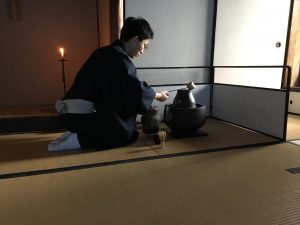We left the hostel by 9:25am this morning to meet Dairiku Amae by the shrine he gathers his water from. It was great meeting Dairiku in person as I had read so much about him for the past couple of weeks. Today was our first day in Kyoto where it was raining. Although that may have made some aspects of the day more difficult, in my opinion, it set a mood that was fitting for the tea ceremony. However, we also learned that because it was raining, water is not usually gathered from the shrine on days like today because a lot of pollutants can get mixed in with the water. Purity and freshness was something that was emphasized in everything we did. However, Dairiku still did gather the water for demonstration purposes, and then we followed Dairiku as he went to the tea shop to buy ceremonial matcha tea, and then to a sweets shop. It was amazing to see a shop that specializes in solely making sweets for the tea ceremony (and was glad to see that it survives here as a business with that as a product) and we bought a mochi with a yuzu filling that the shop owner had picked. Again, those sweets were made fresh. From there, we went to Totousha to continue with the tea ceremony.
It is important to note that this preparation for the tea ceremony is important not only so we can conduct the tea ceremony afterwards. The process of the preparation is important in and of itself. We saw similar themes throughout the duration of the day. For example, the process of creating and drinking the tea during the ceremony is more important than the taste and quality of the tea itself. The word we learned to describe the tea ceremony is “Te-Mae” which means “point in front” in Chinese characters. It can be thought of as tea ceremony meditation. This form of drinking tea is different than just drinking tea for the taste buds—it is an active form of meditation. The entire process of the tea ceremony is working with this idea of an active meditation. We had an activity where we had 6 objects and picked each up individually. They were simple objects but we worked to become more aware of those selected objects—to notice their weight, how they feel, and what’s special about them. Similarly, during the tea ceremony, the lights of the room were dim, and the limitation of our sight (a sense we so often privilege) forced us to become more aware of our other senses.

Dairiku Amae during the Tea Ceremony
Overall, I left today feeling a lot of ease. We learned that the essence of the tea ceremony is that it is an offering/gifting to a stranger. It is important to Dairiku to give people a moment to become more aware of the sound of the river, sight of the mountain, or smell of the rain on the concrete. I definitely felt this sense during the tea ceremony today, but I have also been working on maintaining this mindset even after we left the tea ceremony. I enjoyed the encouragement in greater mindfulness today and I’m grateful for it as it’s something I hope to carry with me even after our time in Kyoto.

